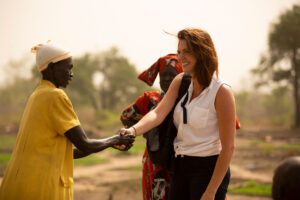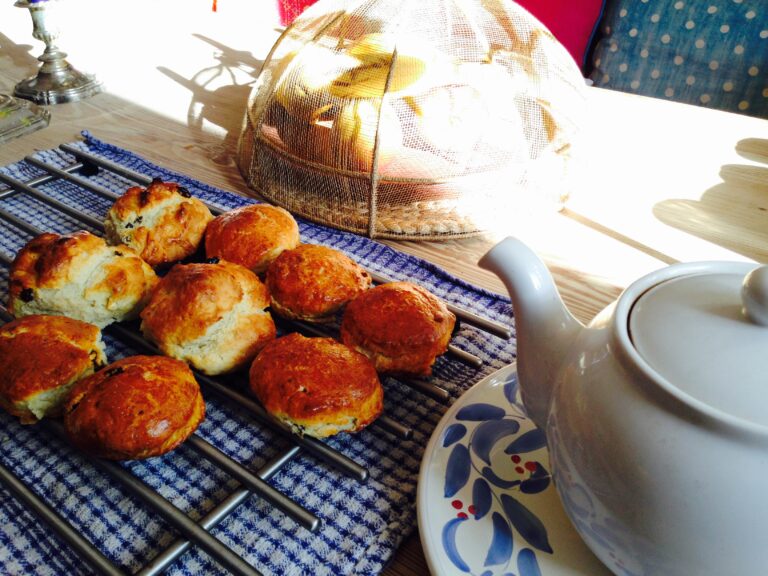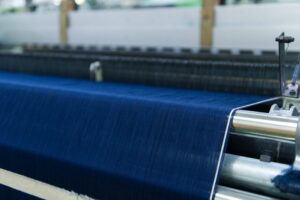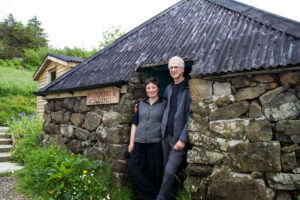
Obakki – A Purpose-Led Lifestyle Brand and Foundation
Founder Treana Peake, supports artisan partnerships and funds development work through the Obakki Foundation.
USA
Mood of Living May 10, 2016
Jewelry designer Lena Skadegard doesn’t rely on carat weight or diamond count to make a statement; instead, in her hand-crafted jewelry, she draws from nature’s subtle nuances and energy of the raw stones. Her “floating gems” and crochet necklaces, hand-tied bracelets and iridescent earrings, favored by the likes of Kelly Rowland and Erin Heatherton, embrace the crude imperfections of gems, shells and minerals in a stark, modern manner. These humble adornments readily assume any personal meaning through harmonious layers and combinations of stones, as well as astute incorporation of artifacts and talismans; collected and paired all over the world, they also quench a city dweller’s wanderlust and thirst for connection with Earth and with themselves.
Born in New Jersey to a Danish father and mother of Kashmiri descent, Lena absorbed the mystical aspect of her heritage from her first steps, developing an early fascination with Indian astrology and belief in the talismanic power of jewelry. Today, she collects her colorful mosaics of “perfectly flawed” bright stones in Jaipur (“It’s a landscape, an incredibly three-dimensional painting,”—she says of the piles of semi-precious and precious stones, the predecessors of her jewels), Denmark, New York & Arizona and works with family workshops & women’s collectives in Delhi to create her supercharged strings. And just as the raw stones rhyme so effortlessly in chaotic détruits, Lena Skadegard’s creations layer beautifully, each piece bringing out the other and creating a whole “miniature world.”
Still, it is not only gems and magic in Lena’s life. She spent her twenties in Paris studying fine art and later in NYC pursuing a degree in painting and international Social Work and philosophy. She exudes the soft shining of this complexly layered yet elemental view of the world. Lena believes that it’s our natural desire to infuse meaning into things: “It’s what we choose to believe and the manifestation we decide to believe in—a tangible object that reinforces what we are and what we believe. To me, that’s what a talisman is.”
Mood of Living: What inspired you to become a jewelry designer?
Lena Skadegard: The notion that palettes and organic textures can be translated as adornments.
MoL: Where did you learn your craft?
L.S: On the road, in New York, Hawaii and India.
MoL: Where do you look for inspiration?
L.S: Always to the stones, as well as to everyday landscapes.
MoL: What was your “aha” moment when you realized you wanted to create jewelry?
L.S: This was a gradual process, I was creating pieces of jewelry that combined vintage tribal gold with raw agates and gems on Hawaiian hand-tied cord to pass the time while working in textile production. People began to order the pieces and the jewelry grew and came out on its own.

MoL: You use a lot of raw, untreated gems. Why? What attracts you in their natural shape?
L.S: I love this saying: “Why gild the lily?” (The original quote comes from King John by William Shakespeare: “Therefore, to be possess’d with double pomp, To guard a title that was rich before, To gild refined gold, to paint the lily . . . Is wasteful and ridiculous excess” – editor’s note.) Stones are like people – more beautiful when left in their original, most integral state. Beauty is a matter of context. I think, the less controlled, the better.
“You can get perfect Herkimers that look like diamonds, and you can get flawed Herkimers that are more like human beings—they’re beautifully imperfect, with these unique inclusions, so no two are alike.”
I was at an artist residency program in Vermont and met a man who introduced me to Herkimer diamonds, named for the county in Upstate New York where they are mined. He had a truck, and in that truck was a mound of dirt, and in that mound of dirt were all these sparkly things. He offered me to take what I like, but I decided to go straight to the mine instead. You can get perfect Herkimers that look like diamonds, and you can get flawed Herkimers that are more like human beings—they’re beautifully imperfect, with these unique inclusions, so no two are alike. I remember the owner saying she had double-As, triple-As, and I was like, “No, no—show me your rejected stones.”
MoL: What is the meaning of the talismans—ancient-looking Buddhas and mascots—you use in your jewels? Why did you decide to use them?
L.S: Talismans are reminders of what we aspire to, integrating this as adornment allows the jewelry to have a profound significance. We are creating identity when we dress and adorn ourselves.
MoL: Do you have a personal talisman?
L.S: A ring from my sister worn as protection during travel, three emerald pinky rings that I haven’t taken off since my first year designing jewelry to remind me of the beginning of all aspirations. For me, talismans are everywhere, and they change daily.
MoL: How did your background in philosophy influence your designs?
L.S: Studying philosophy in the way we did at St. John’s College Great Books Program—through seminars—taught me to think critically, ask questions, learn through dialogue. It relates to the way that all good things seem to result from the collaboration. And every piece of jewelry is equally a result of collaborative efforts. There are no rules in the study of beauty.
MoL: Tell us about your international experience. What countries influenced you the most?
L.S: A tri-cultural upbringing meant that Denmark (where my father is from) and Kashmir in the Himalayan mountains (where my mother is from) were for as much of a ‘home’ as was New Jersey. Landscape, aesthetic and culture in both India and Denmark naturally informed my developing sensibility: the palettes and light of Scandinavia and the dynamic paradoxes and exquisite craft traditions of India are hugely important to how I see the world.
MoL: What is beauty to you? What and who do you consider beautiful?
L.S: Nature without human intervention.
MoL: How is your nomadic lifestyle reflected in your perception of beauty?
L.S: Crossing borders is my ‘normal’. The spaces between are more important than lines that divide. Travelling empowers one to identify similarities in cultures, to recognize notions of identity as purely contextual and to understand the human conditions as one condition, not many.
MoL: What about traditional handmade craft? Tell us about your first encounter with it?
L.S: The furniture in my childhood home was mostly built by my father. He designed and made L-shaped sofas with built in corner tables,—very 1970s Scandinavian—timelessly elegant book and LP shelving, and very cool modern bed frames. He built the frames for my mother’s paintings and the bases for her sculptures, beautifully conceived in proportion and material. So the house was a curation of his furniture and Tibetan copper and silver horns (used as standing lamps), rustic fisherman’s basket chandeliers, hand-loomed silk Kashmiri rugs, whittled wooden cutlery, Mexican earthen pots for flowers, Rajasthani soapstone plates, Peruvian ponchos, Swedish hand-loomed blankets, my Grandmother’s knitted sweaters, hand thrown pottery from Hungary and Romania, and much more. I didn’t ponder it, however, I now see how fortunate we were to be surrounded by such beautiful hand-crafted functional objects. It was the beginning of everything.
MoL: How has your view of the traditional crafts evolved?
L.S: The novelty aspect of ‘craft’ is evolving as respect grows for the knowledge-base and rarity of understanding of techniques that cannot be reproduced artificially. The space between Fine Art and traditional craft is gradually closing via recontextualization: more and more fine artists fetishize, appropriate or incorporate hand-made and traditional techniques and crafts, such as weaving, knitting, embroidery, woodwork and so on. Eventually, this creates awareness.
MoL: What is the future of traditional crafts in the modern world?
L.S: Respect for the aesthetic of certain craft traditions continues to grow and broadens our perception of design and beauty. Ideally, ‘craft’ will be a word that is no longer exoticized or categorized as ‘ethnic,’ but a way of life and a mindful skill to return and aspire to.
MoL: Many of your necklaces are layered – what attracts you to this idea?
L.S: Opulence, unexpected relationships – layering is a personal curation of beauty.
MoL: You mention on your website an interesting concept of ‘friendships amongst gems and stones.’ Can you elaborate on this? Which stones are ‘friends’ and which aren’t? What are your favorite pairs?
L.S: They are ALL friends! It’s a matter of how they ‘sing’ when placed together, but all of them are always in conversation with each other. Frequently I start seeing a harmony in certain juxtapositions that had not occurred to me before.
MoL: It is a widespread belief that stones carry energy. What are your thoughts on this? Do you have a story to illustrate the energetic effect of gems?
L.S: Stones are vibrations or energy. Each stone is infused with certain frequencies. It is an ancient belief as well as a physical reality.
MoL: Do you have a hobby?
L.S: Reading and yoga.
MoL: What is your favorite quote?
L.S: I find myself saying, “Not my circus, not my monkeys…” a bit too often… A better favorite quote is one by Albert Einstein that has to do with what we just talked about: “Everything is energy, and that’s all there is to it. Match the frequency of the reality you want, and you cannot help but get that reality. It can be no other way. It is not philosophy. It is physics.”

MoL: Who is an influential figure in your life?
L.S: My friends and family. Ancestors. In business, Darina Byrne of The Wardrobe Guru, my guru in all things ethical in fashion! She just gets it.
MoL: What is the best advice you’ve ever received and who gave it to you:
L.S: Every major and minor religion and spiritual practice teaches some variation of it: Compassion, Service, Forgiveness, Humility.
MoL: Where do you go for peace of mind and spirit?
L.S: Lodhi Gardens, Hyde Park, meditation or yoga practice.
MoL: We find that people who make beautiful things are more likely to lead an artistic lifestyle. Do you spend much time creating a beautiful home?
L.S: I am obsessed with creating a beautiful home, even in a hotel room. The environment is a canvas wherever I go!
MoL: Do you entertain? Do you cook? If so, do you have photos of your home and do you have a favorite recipe you would like to share?
L.S: I rarely have time, though I am a good cook when time permits, and I love entertaining, especially outdoors in London. Usually, I stick with Mediterranean style. My top three recipes are:
MoL: What advice can you give anyone interested in starting his or her own business?
L.S: There are no rules. Work hard and stay true to your vision, make time for dream time and always keep learning.
Photography courtesy by Lena Skadegard

Founder Treana Peake, supports artisan partnerships and funds development work through the Obakki Foundation.

Tatsushi Kuroki has made a career of infusing sustainability into the denim production process.

Andrea and Roger Holden traded in their agricultural lifestyle to set up a textile company in Scotland.